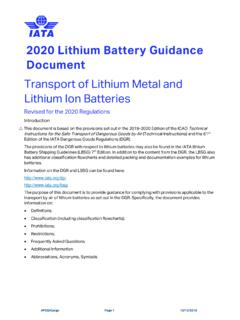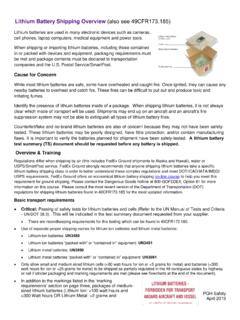Transcription of How to safely pack and ship batteries
1 How to safely pack and ship batteriesEffective date: May 2019 How to safely pack and ship batteriesEffective May 2019112ID INID u2mberPo2pShiPn2gPhaeiP2ds2ctPheiSH2zbiC 2mpgH2rlP2mpg2 UhSbotSh72 Sbo2rlP2idndh2 Uhd9b2 ShP2rhSoPtSh742ds2mberPo2pShiPn2gPhaeiP2 ds2ctPheiSH2zbiC2cnn2he5lr42hP4 PhaPoC280 uAlthough they are very common today in portable electronics, tools and other applications, batteries can be a source of dangerous heat, sparks or fire if they are improperly packaged for shipping. For this reason, UPS customers must follow applicable safety regulations and appropriate precautions when preparing batteries for transportation. Battery shipments may be subject to both and international safety regulations, and because of the potential dangers associated with violations of those regulations, people who do not follow the regulations when packing their shipments could be subject to fines or other has assembled this illustrative guide to help you safely pack and ship many kinds of batteries .
2 In some cases, such as with alkaline or certain nonspillable lead-acid batteries , your responsibilities may be limited to simple steps such as: selecting strong outer packaging; carefully protecting battery terminals to prevent sparking or short circuit; and carefully preparing the interior package components to keep tools or other metal objects away from types of batteries , including lithium ion and lithium metal types, may be fully regulated as hazardous materials (also known as dangerous goods) for transportation, so that in addition to those basic safety precautions they require use of specialized packaging, specific hazard labeling, and specific documents certifying compliance with the applicable shippers are required to understand and comply with the applicable regulations and UPS tariffs.
3 This guide provides general information about shipments governed by regulations published by the International Air Transport Association (IATA), and the Department of Transportation s Pipeline and Hazardous Materials Safety Administration (PHMSA), Additionally, other international regulatory requirements apply, such as the International Maritime Dangerous Goods (IMDG) Code, ADR Dangerous Goods Regulations for European Road Transport, or Transport Canada Dangerous Goods Regulations (TDGR).How to safely pack and ship batteriesProtect batteries and terminalsWhen shipping almost any battery, you must protect all terminals against short circuits that can result in fires. Protect terminals by completely covering them with an insulating, non-conductive material ( , using electrical tape or enclosing each battery separately in a plastic bag), or packing each battery in fully enclosed inner packaging to ensure exposed terminals are protected.
4 Package the batteries to keep them from being crushed or damaged, and to keep them from shifting during handling. Always keep metal objects or other materials that can short circuit battery terminals away from the batteries ( , using a separate inner box for the batteries ).Note: To prevent fire, any device with installed batteries must not turn on while in transport. Protect switches that can be accidentally activated. Even very simple devices like flashlights or rechargeable drills can generate a dangerous amount of heat if accidentally or recycled batteriesNever use Air services to ship batteries recalled by the manu facturer for safety reasons, as such shipments are prohibited by regulation ( , IATA Dangerous Goods Regulations, Special Provision A154).
5 Also, batteries accumulated for recycling may not be sent via Air services: UPS Ground service between Alaska, Hawaii or Puerto Rico and the continental is unavailable for either recalled or recycled batteries , as shipments to or from these points must travel by aircraft for at least one flight wishing to transport damaged, defective or recalled (DDR) batteries must be pre-approved by UPS. UPS only accepts DDR shipments via Ground Continental Service in special permit packaging designed to contain a thermal event. Contact your Sales Team for more to safely pack and ship batteriesEffective May 2019212ID INID u2mberPo2pShiPn2gPhaeiP2ds2ctPheiSH2zbiC 2mpgH2rlP2mpg2 UhSbotSh72 Sbo2rlP2idndh2 Uhd9b2 ShP2rhSoPtSh742ds2mberPo2pShiPn2gPhaeiP2 ds2ctPheiSH2zbiC2cnn2he5lr42hP4 PhaPoC280 uElectronic items for repairWhen sending equipment for repairs, such as computers and cell phones or other battery operated devices, if there is any risk that the device could overheat, it should be sent without agenciesWhat do the abbreviations IATA and PHMSA mean?
6 IATA is the International Air Transport Association. It is a global trade organization that develops commercial standards and publishes the Dangerous Goods Regulations, containing standards for the transport of dangerous goods by air. IATA s Dangerous Goods Regulations are based on the International Civil Aviation Organization (ICAO) Technical Instructions for the Safe Transport of Dangerous Goods by Air. ICAO is the United Nations body with jurisdiction over international aviation is the Pipeline and Hazardous Materials Safety Administration of the Department of Transportation, which develops regula-tions for transport of dangerous goods by all modes within the of batteriesThere are a variety of batteries available today and, while in transport, many are regulated as hazardous materials (also known as dangerous goods)
7 That may only be shipped with UPS by shippers with contracts for hazardous materials/dangerous goods NumberProper Shipping Name and DescriptionHazard ClassUN2794 batteries , Wet, Filled with Acid8UN2795 batteries , Wet, Filled with Alkali8UN2800 batteries , Wet, Nonspillable8UN3028 batteries , Dry, Containing Potassium Hydroxide Solid8UN3090 lithium Metal Batteries9UN3091 lithium Metal batteries Contained in Equipment or lithium Metal batteries Packed with Equipment9UN3292 batteries , Containing Ion Batteries9UN3481 lithium Ion batteries Contained in Equipment or lithium Ion batteries Packed with Equipment9 Some of the battery types shown above may be shipped under regulatory exceptions that provide relief from the full requirements of the hazardous materials/dangerous goods regulations.
8 In addition, there are some battery types ( , conventional dry cell or alkaline batteries in consumer sizes) that are not regulated at all, provided they are adequately protected against short this document is designed to highlight safety practices for UPS customers who pack and ship batteries , it does not replace the applicable regulations. For more information, consult the DOT s Hazardous Materials Regulations (49 CFR). You may also consult DOT s online information at , or call the DOT s Hazardous Materials Information Center at 1-800-467-4922. International air shipments may additionally be subject to the Dangerous Goods Regulations of the International Air Transport Association (IATA). For more infor mation, see or check local to safely pack and ship batteriesEffective May 2019312ID INID u2mberPo2pShiPn2gPhaeiP2ds2ctPheiSH2zbiC 2mpgH2rlP2mpg2 UhSbotSh72 Sbo2rlP2idndh2 Uhd9b2 ShP2rhSoPtSh742ds2mberPo2pShiPn2gPhaeiP2 ds2ctPheiSH2zbiC2cnn2he5lr42hP4 PhaPoC280 uTypes of batteries (cont.)
9 Wet batteries (UN2794 and UN2795) These batteries are commonly used in cars, electric wheelchairs, forklifts, some continuous computer power sources and other applications. They contain highly corrosive acid or alkali and can cause fires from short circuit. All terminals must be protected against short circuit, and the batteries packaged and tested according to 49 CFR for shipments, or IATA Section 5, Packing Instruction 870. Note that regardless of service level, small package shipments must use packaging prescribed for air shipment , the air shipments must include an acid- or alkali-proof liner, or include supplementary packaging with sufficient strength and adequate seals to prevent leakage of electrolyte fluid in the event of spillage (see Figs.)
10 1 and 2). In regard to Figure 2, packages must be packed using a leak-proof liner. A rugged plastic bag resistant to the corrosive electrolyte is one way to create a leak-proof liner. Applicable shipping paper/Declarations for Dangerous Goods requirements must be Leak-proof LinerFigure 2 Sample Packaging Multiple Wet BatteriesTerminal ProtectionStrong Outer PackageNon-Conductive DividerInsulating CapInner ContainerNonspillable batteries (UN2800) These batteries may not be subject to the Hazardous Materials Regulations if they meet the pressure differential and vibration testing in 49 CFR , as well as being plainly and durably marked either NONSPILLABLE or NONSPILLABLE BATTERY on the outer packaging (see Fig. 3).













